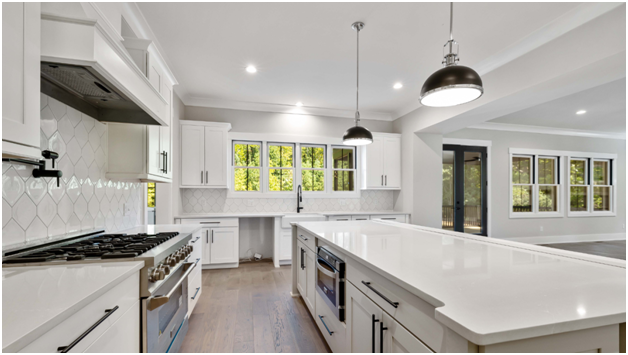
The kitchen is one of the most energy-consuming areas in any home. From cooking appliances to lighting and refrigeration, energy use in the kitchen can add up quickly. Fortunately, making small, intentional changes can help lower your energy consumption, reduce utility bills, and create a more sustainable home. Whether you’re remodeling or looking for simple upgrades, here are 10 ways to make your kitchen more energy-efficient.
1. Upgrade to Energy-Efficient Appliances
Modern energy-efficient appliances use less electricity and water while still providing the same (or even better) performance. Look for Energy Star-rated refrigerators, dishwashers, and ovens, which are designed to consume less power while maintaining high functionality.
Benefits:
- Lower electricity and water bills.
- Reduced environmental impact.
- Improved appliance longevity.
If you’re planning a remodel, working with an experienced kitchen designer can help you select the most efficient appliances for your space.
2. Switch to LED Lighting
Lighting plays a big role in energy consumption, and traditional incandescent bulbs waste a significant amount of energy as heat. Switching to LED bulbs can save up to 80% of lighting energy compared to traditional options.
Benefits:
- Longer-lasting bulbs (up to 25 times longer than incandescent bulbs).
- Lower energy usage and reduced cooling costs.
- Available in various colors and brightness levels to suit your space.
Consider installing under-cabinet LED lighting for a modern, energy-efficient touch.
3. Optimize Your Refrigerator Usage
Refrigerators run 24/7, making them one of the biggest energy consumers in your kitchen. Proper maintenance and smart usage can make a significant difference in energy efficiency.
Tips to Reduce Energy Use:
- Keep the fridge temperature between 35-38°F and the freezer at 0°F.
- Avoid overloading or leaving the door open for long periods.
- Regularly clean the condenser coils to improve efficiency.
- Place your refrigerator in a cooler area away from direct sunlight or heat sources.
4. Use Smart Cooking Methods
Your cooking habits can also impact your kitchen’s overall energy efficiency. Using the right techniques can save both time and energy.
Energy-Saving Cooking Tips:
- Use convection ovens, which cook food faster using less energy.
- Match pot sizes to burner sizes to avoid wasted heat.
- Use lids on pots and pans to trap heat and cook food more quickly.
- Utilize small appliances like air fryers, toaster ovens, or slow cookers instead of heating up a full-sized oven.
5. Install a Water-Efficient Faucet
Kitchen faucets are a primary source of water consumption, but you can reduce waste by switching to a low-flow or aerated faucet. These models use less water per minute without compromising performance.
Benefits:
- Reduces water bills.
- Lowers hot water usage, cutting down on energy costs.
- Helps with sustainability efforts in your home.
Pair this upgrade with energy-efficient dishwashing habits, such as running full loads and air-drying dishes instead of using heat drying cycles.
6. Improve Kitchen Insulation
Good insulation helps maintain indoor temperatures, reducing the need for heating and cooling. Proper insulation in walls, floors, and ceilings keeps your kitchen comfortable year-round.
Tips to Improve Insulation:
- Seal any air leaks around windows and doors.
- Use thermal curtains or blinds to regulate temperature.
- Insulate pipes to reduce heat loss from hot water systems.
A well-insulated kitchen contributes to overall home energy efficiency.
7. Use Renewable Energy Sources
If you’re looking for long-term sustainability, consider incorporating renewable energy sources into your kitchen design.
Options Include:
- Solar panels to power appliances and lighting.
- Geothermal heating for eco-friendly temperature control.
- Smart power strips to cut energy waste from plugged-in appliances.
While these upgrades may require an initial investment, they pay off in long-term energy savings.
8. Maximize Natural Light
Reducing reliance on artificial lighting by utilizing natural light is an easy and effective way to save energy.
How to Do It:
- Install larger windows or skylights for more daylight.
- Use light-colored paint to reflect light and brighten the space naturally.
- Position workspaces near windows to minimize daytime artificial lighting needs.
A kitchen designer can help incorporate natural lighting into your remodel for a bright and energy-efficient space.
9. Choose Energy-Efficient Flooring and Materials
Certain materials retain heat better, keeping your kitchen comfortable without excess heating or cooling.
Best Energy-Efficient Materials:
- Cork flooring – Provides insulation and is comfortable to stand on.
- Recycled glass countertops – A sustainable and durable option.
- Bamboo cabinetry – A renewable material that adds warmth and style.
Choosing eco-friendly materials reduces waste and promotes sustainability.
10. Practice Smart Energy Habits Daily
Even small daily habits can lead to big energy savings over time.
Simple Ways to Save Energy:
- Unplug appliances when not in use.
- Use a dish rack instead of heated drying cycles.
- Cook in batches to reduce oven usage.
- Defrost frozen food in the fridge instead of using the microwave.
By making mindful energy choices, you can create a more sustainable and cost-effective kitchen.
Transforming your kitchen into an energy-efficient space doesn’t require a complete overhaul. By upgrading to LED lighting, optimizing appliances, reducing water waste, and utilizing natural light, you can significantly cut down on energy use. Whether making small adjustments or planning a full remodel, working with a kitchen designer can help you create an energy-efficient kitchen that blends style, function, and sustainability.

